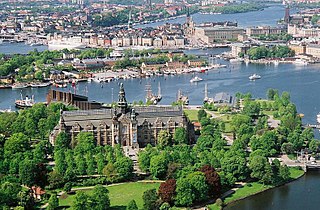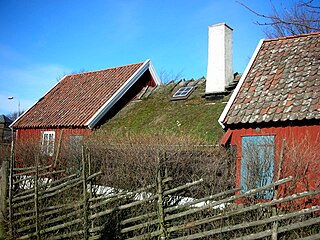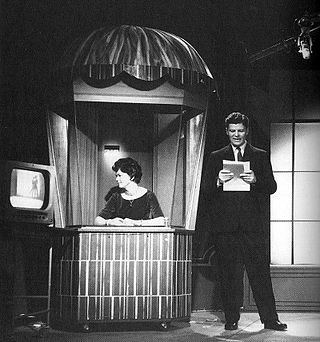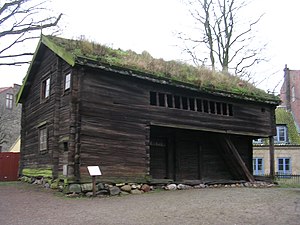
Lund is a city in the southern Swedish province of Scania, across the Öresund strait from Copenhagen, Denmark. The town had 91,940 inhabitants out of a municipal total of 121,510 as of 2018. It is the seat of Lund Municipality, Scania County. The Öresund Region, which includes Lund, is home to more than 4.1 million people.

The Swedish History Museum is a museum located in Stockholm, Sweden, that covers Swedish archaeology and cultural history from the Mesolithic period to present day. Founded in 1866, it operates as a government agency and is tasked with preserving Swedish historical items as well as making knowledge about history available to the public.

Artur Immanuel Hazelius was a Swedish teacher, scholar, folklorist and museum director. He was the founder of both the Nordic Museum and the Skansen open-air museum in Stockholm.

An open-air museum is a museum that exhibits collections of buildings and artifacts outdoors. It is also frequently known as a museum of buildings or a folk museum.

The Nordic Museum is a museum located on Djurgården, an island in central Stockholm, Sweden, dedicated to the cultural history and ethnography of Sweden from the early modern period to the contemporary period. The museum was founded in the late 19th century by Artur Hazelius, who also founded the open-air museum Skansen. It was, for a long time, part of the museum, until the institutions were made independent of each other in 1963.

Falsterbo is a town located at the south-western tip of Sweden in Vellinge Municipality in Skåne. Falsterbo is situated in the southern part of the Falsterbo peninsula. It is part of Skanör med Falsterbo, one of Sweden's historical cities.

Georg Fredrik Johansson (J:son) Karlin was the founder of the Kulturen open-air museum in Lund, Sweden.

Djurgårdsbrunnsviken is a bay in central Stockholm, Sweden, together with the canal Djurgårdsbrunnskanalen forming the northern shore line of the island Djurgården. The bridge Djurgårdsbron stretches over the bay.

Djurgården or, more officially, Kungliga Djurgården, is an island in central Stockholm, Sweden. Djurgården is home to historical buildings and monuments, museums, galleries, the amusement park Gröna Lund, the open-air museum Skansen, the small residential area Djurgårdsstaden, yacht harbours, and extensive stretches of forest and meadows. It is one of the Stockholmers' favorite recreation areas and tourist destinations alike, attracting over 10 million visitors per year, of which some 5 million come to visit the museums and amusement park. The island belongs to the National City park founded in 1995. Since the 15th century the Swedish monarch has owned or held the right of disposition of Royal Djurgården. Today, this right is exercised by the Royal Djurgården Administration which is a part of the Royal Court of Sweden.

The Bexell Cottage is a small cottage in Varberg, Sweden. It has been turned into a historical heritage mini-museum. In Bexell Cottage there are furnitures and painted wall tapestry from the 19th century. The tapestry cover the walls and ceiling of the cottage. Originally, they were only used for Christmas, but today they are posted all the year around. Bexell Cottage can be visited by the public at the shows of the cottage that are arranged by Halland Museum of Cultural History.

Nils Erik Bæhrendtz was a Swedish literary historian, and radio and television personality. Bæhrendtz played an important role in creating Sweden's first television news show Aktuellt, and in bringing new television show formats to Sweden. He was head of Swedish Radio and Swedish Television during the 1960s. After his sudden resignation as powerful manager, he was the executive president of the Skansen open-air museum foundation in Stockholm during the 1970s.

Bunge is a populated area, a socken, on the Swedish island of Gotland. It is situated in the northernmost part of Gotland, southwest of Fårösund. It comprises the same area as the administrative Bunge District, established on 1 January 2016.
Events from the year 2001 in Sweden

The Gotland Museum in Visby, Sweden, is the county museum of Gotland. It was founded by the Friends of Gotland's Antiquity society in 1875, at the initiative of Pehr Arvid Säve. The museum owns a number of houses and farms on Gotland, some of which are used as museums. It also has a publishing house for books on subjects related to the island's heritage.

General Axel Georg Ljungdahl was a Swedish Air Force officer. He was Chief of the Air Force from 1954 to 1960.

Knut Martin Stjerna was a Swedish archaeologist and scholar, notable for a number of papers analyzing Beowulf from an archaeological perspective. He was a lecturer at Uppsala University, where he taught, among others, Birger Nerman and Sune Lindqvist.

Josef Gunnar Torhamn, born Olsson, was a Swedish painter and sculptor, particularly noted for his work on church interiors.

Märta Livia Vilhelmina Måås-Fjetterström was a leading Swedish textile artist in the early 20th-century. She is remembered in particular for the weaving studio she opened in Båstad in 1919 and for the decorative rugs she produced from the 1910s to the 1930s, increasingly combining rural Nordic traditions with modernist trends. Her works are exhibited in some of the world's most important art museums, including New York's Metropolitan Museum of Art and London's Victoria and Albert Museum.

Gunnel Gunnarsdotter Hazelius-Berg née Hazelius (1905–1997) was a Swedish museum curator, textile researcher and writer. She spent her entire professional career at Stockholm's Nordic Museum. As the director responsible for textiles, over the years she arranged several highly acclaimed exhibitions. Hazelius-Berg took a special interest in traditional Swedish costumes. Together with her daughter-in-law Inga Arnö-Berg, in 1975 she published Folkdräkter och bygdedräkter från hela Sverige which was translated into English as Folk Costumes of Sweden: A Living Tradition.

Västernorrland County Museum is the regional museum of Västernorrland County, Sweden. One of Sweden's 24 county museums, Västernorrland County Museum has the aim to preserve and transmit the cultural history of Västernorrland. The collections are based on history, archaeology, ethnology, culture and art. The museum's head office is currently located at Härnösand in Härnösand Municipality. Among the museum's many activities, the extensive exhibition activities are one of the most important. Other very important activities concern the preservation of old buildings and the care of the county's cultural heritage environments and archaeological sites, a work that is carried out in collaboration with the County Administrative Board of Västernorrland. The museum serves all inhabitants in the county. It documents both prehistorical and historical structures in the county and promotes the visiting of them. The current museum director is Jenny Samuelsson and the current chairman is Carl L. Thunberg. Among the areas covered by the museum is the UNESCO World Heritage Site of the High Coast area.
























